COTONOU, October 26, 2010—Community Driven Development (CDD) is a decentralized approach to development that focuses on priorities identified by beneficiary communities themselves, assigns ownership to them, and provides them with the resources needed to take an active role in transforming their lives for the better.
In 2005, Benin decided to adopt a CDD approach through the National Community-Driven Development Support Project, known by its French acronym PNDCC (Projet National de Développement Conduit par les Communautés). The project’s objective was to improve access for the poorest communities to basic social and financial services. The World Bank funded the project to the tune of US$50 million (approximately CFAF 34 billion) through the International Development Association, the branch of the World Bank Group that provides assistance to low income countries. Of that money, US$37.7 million was in the form of a loan, and US$12.3 million in the form of a grant.
The project’s main components included strengthening the capacities of sectoral ministries, communes, and communities in order to implement CDD, expanding access by the poor to basic infrastructure and social services, and improving access by the poor to financial services targeting revenue-generating activities.
Tangible Results
All told, 1,196 poor communities of the 1,515 targeted received PNDCC funding to implement 1,231 community subprojects. In addition, 63 of the 74 communes targeted received funding to implement 89 communal subprojects described in their Communal Development Plan (CDP); and 295 additional subprojects were approved for start in the months ahead. The PNDCC led to the building and rehabilitation of much of the basic community and communal social infrastructure throughout the country.
The project provided funding for the construction of 2,568 classrooms and 120 health care centers (dispensaries, maternity facilities, and village health centers). In addition, 206 modular latrines (with two to four stalls) as well as a large number of market-based infrastructures (modular shops, storage facilities, and market stands) were also built. Feeder roads and other basic infrastructure such as wells and boreholes were also rehabilitated or built.
Above all, the PNDCC managed to develop the capacities of the main actors on the ground. It is important to note that community subprojects are identified, prepared, and implemented by the communities themselves, through Village Development Associations (ADVs), with the assistance of leaders from the relevant communities and communes. All ADVs receive basic management training in many areas (such as participatory poverty assessment, participatory needs assessment, community procurement, and financial management) before starting work.
The project organized basic management training for more than 1,515 of the poor communities targeted. This training allowed the beneficiary communities to organize themselves to prepare subprojects eligible for PNDCC funding, and to execute them by concluding contracts with enterprises. They also made sure to supervise the works themselves. The 74 Communes involved, along with each of the 12 prefectures in the country, also undertook capacity-building activities that incorporated the community-driven development approach into their programs.
The objective of providing the poorest with access to financial resources so that they can develop income-generating activities was also achieved. Through a partnership concluded between the Project and six microfinance institutions, 3,600 groups (90 percent of members are women) received loans and technical advice to launch their economic activities.
“In addition to the infrastructure work that we did in the context of the PNDCC, the training we received was very important and valuable,” noted a village development association member. “The skills acquired, which allowed us to prepare and execute our own microprojects, position us to be true drivers of our own development.”
Empowering Women
The CDD experience in Benin has been a success on several fronts. In particular, it enabled capacity building in ministries, communes, and grassroots development organizations tasked with implementing operations; expanded access by the poor to social services, basic infrastructure, and financial services to carry out revenue-generating activities; and facilitated the government’s agreement to transfer financial resources to communes and communities.
There is broad consensus that no meaningful development can be achieved without gender inclusion and women empowerment. Consequently, steps were taken to ensure adequate representation by women in the resource management area of projects. Their participation was therefore expanded and they were assigned greater responsibility for microproject implementation.
This enhanced the autonomy of women in the beneficiary communes and communities and facilitated their participation in the decision-making process. Women were also the main beneficiaries of the partnership between the PNDCC and microfinance institutions. They received loans and technical advice to start revenue-generating activities which they managed efficiently, thus reaping the benefits of these projects. They were therefore able to quickly repay loans and obtain more credit.
The women we met with during a visit to a cooperative for grassroots development in Bohicon (a microfinance institution) told us that the activities they carried out with loans obtained allowed them to make a much greater contribution to the needs of their families, in particular by investing in children’s health and education.
Future Prospects
While it is true that a lot of activities were carried out in the context of the PNDCC, much remains to be done. “The PNDCC has made a great contribution to building the capacity of communities to identify their own development needs, prepare subprojects, seek financing, supervise the execution of works, as well as conduct audits, preliminary checks, evaluation, and reprogramming,” said Frank Tigri, the project’s executive secretary. “In light of the ever-growing demand from communes and communities, we have stepped up the implementation pace of activities, so as to pave the way for the ongoing technical and financial assistance needed to expand and strengthen access by the poor to basic social services and infrastructure,” he added.
On June 29, 2010, the Board of the World Bank approved an additional financing of US$12 million (approximately CFAF 6 billion) in the form of a grant for the PNDCC. This new funding will help secure the gains made so far and introduce a new component aimed at providing a technical assistance that will help improve the social protection system in Benin.


